culture
On ‘Alternative Walking Tours,’ Formerly Homeless People Share Their Perspectives
After struggling with alcohol addiction for over 10 years — during which his 20-year banking career and 30-year marriage both collapsed — it was a presentation in a rehab center in 2019 that became the catalyst for Miles to turn his life around.
The presentation was by Invisible Cities, an organization which, since its inception in 2016, has trained 118 formerly homeless people to become tour guides. It’s a creative way of giving them not only a new income stream, but also a new sense of purpose — and skillset, too.
“This helped fill a void after I finished rehab,” says Miles, who has withheld his name for privacy reasons. “This was the opportunity that first helped me back on to a path of a ‘normal’ life again, and having a purpose.”
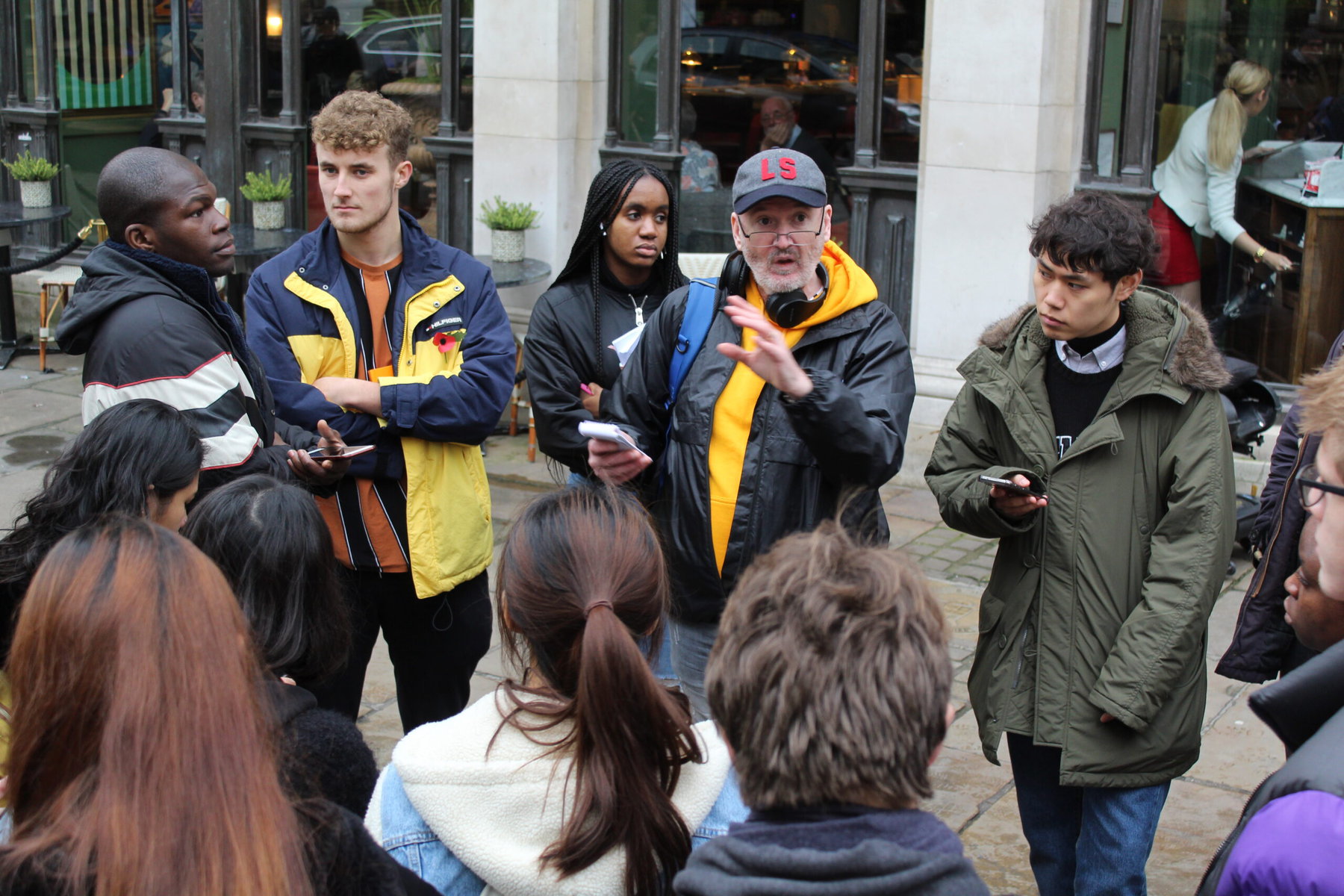 It took Miles six months to put together his tour of York. Courtesy of Invisible Cities
It took Miles six months to put together his tour of York. Courtesy of Invisible Cities
“I probably wouldn’t be where I am today without the opportunity Invisible Cities gave me. I’ll always be grateful for that.”
Invisible Cities’ guides specialize in unique topics that reflect their own personal story — such as a city’s LGBTQI history, notable women, protest culture, ties to witchcraft or how crime and punishment has evolved — in the UK cities of Edinburgh, York, Cardiff, Glasgow and Manchester.
Invisible Cities provides training for guides to create these “alternative walking tours,” as well as in public speaking and customer service skills. The organization is then responsible for marketing the tours and taking bookings. Participants pay up to £15 (around $19 US), which is split between the guide and Invisible Cities to support their efforts in recruiting more guides who have experienced homelessness.
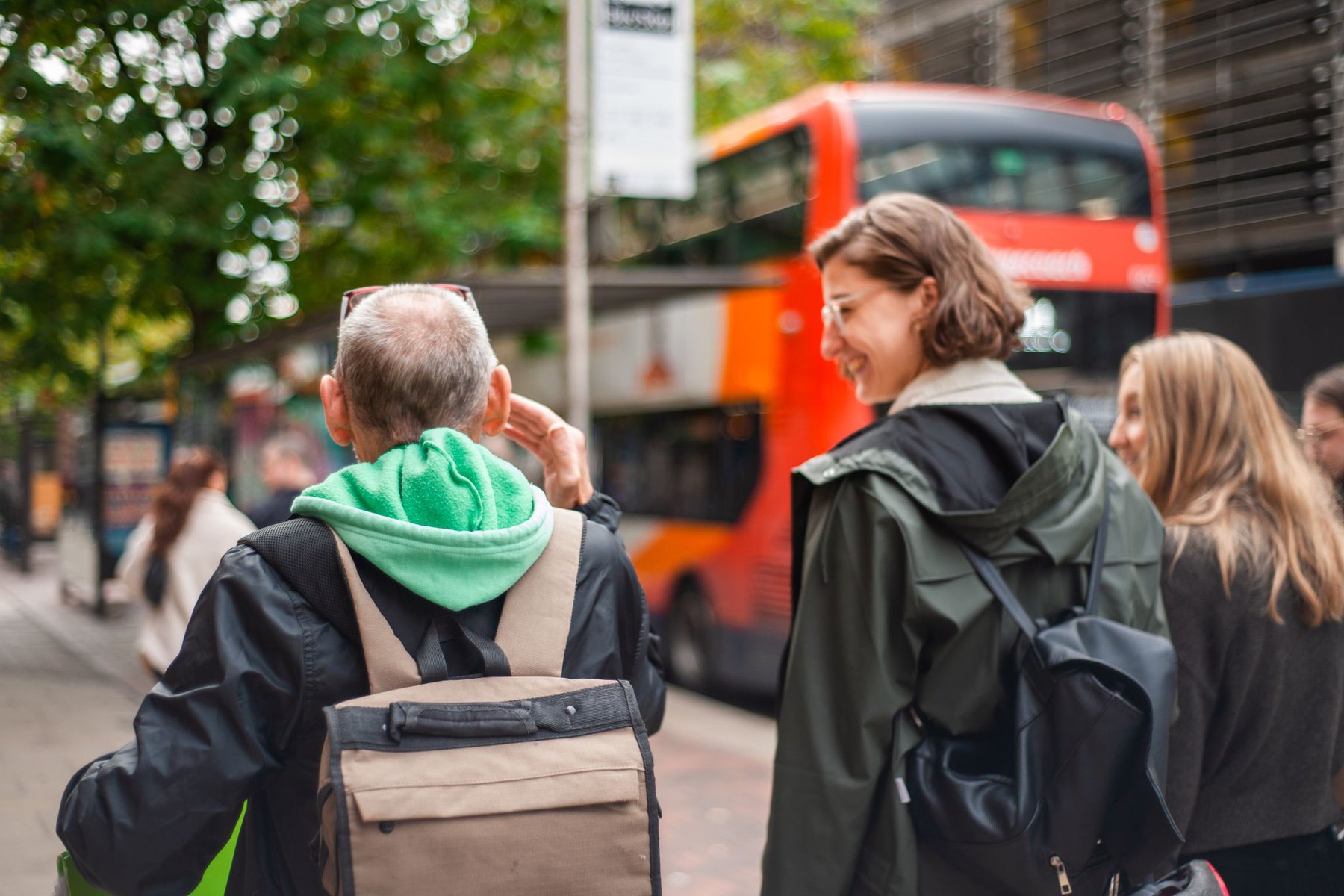 An Invisible Cities guide regales visitors on a tour in Manchester. Courtesy of Invisible Cities
An Invisible Cities guide regales visitors on a tour in Manchester. Courtesy of Invisible Cities
Invisible Cities has also set up a grant program for guides to access funding to do other external courses or start their own business, and offers training in IT and presentation skills to help them gain further employment.
With the help of sponsors, Invisible Cities also offers free community tours for specific groups. In 2023, 569 people from the Ukrainian community and from underprivileged areas attended free tours.
Miles’ tour of the English city of York, in which he has lived for the past 30 years, took him six months to put together. During that time, he transitioned out of the rehab center and into resettlement housing, where he stayed until he moved into his own apartment in 2021.
On his tours, Miles focuses on health and wealth in York, in parallel with his own experience in which his health was compromised due to addiction, and both having and losing wealth. He highlights buildings that have brought either health or wealth to the area, such as St. Leonard’s Hospital, which was one of the first hospitals in the UK, built in medieval times.
Courtesy of Invisible Cities
“This helped fill a void after I finished rehab. This was the opportunity that first helped me back on to a path of a ‘normal’ life again, and having a purpose.”
–Miles, Invisible Cities guide
He also spotlights the city’s chocolate making locations, from the Terry’s Chocolate factory, which manufactured the iconic “chocolate orange” that is a tradition to give and eat at Christmas in the UK, to the Rowntree’s site that created the popular Kit Kat chocolate bar.
“What Terry’s did is they brought employment into the city. But they recognised very early that in order to build their company, they had to provide housing for their staff, and they reinvested their original profits back into their workforce, and into building up the factory,” Miles explains.
Crushed by negative news?
Sign up for the Reasons to be Cheerful newsletter.
[contact-form-7]
“And the same with Rowntree’s, who provided health benefits and housing to their workforce. But Rowntree’s was then taken over by Nestle, a multinational conglomerate, whose profits and investment go out of the city.”
Miles’ tours have evolved over the past five years based on social developments in the city and the questions participants ask. For example, his tours have addressed issues such as gang-related drug dealing, and a lack of accessible parking in the city, and he also weaves in his own experience living with addiction.
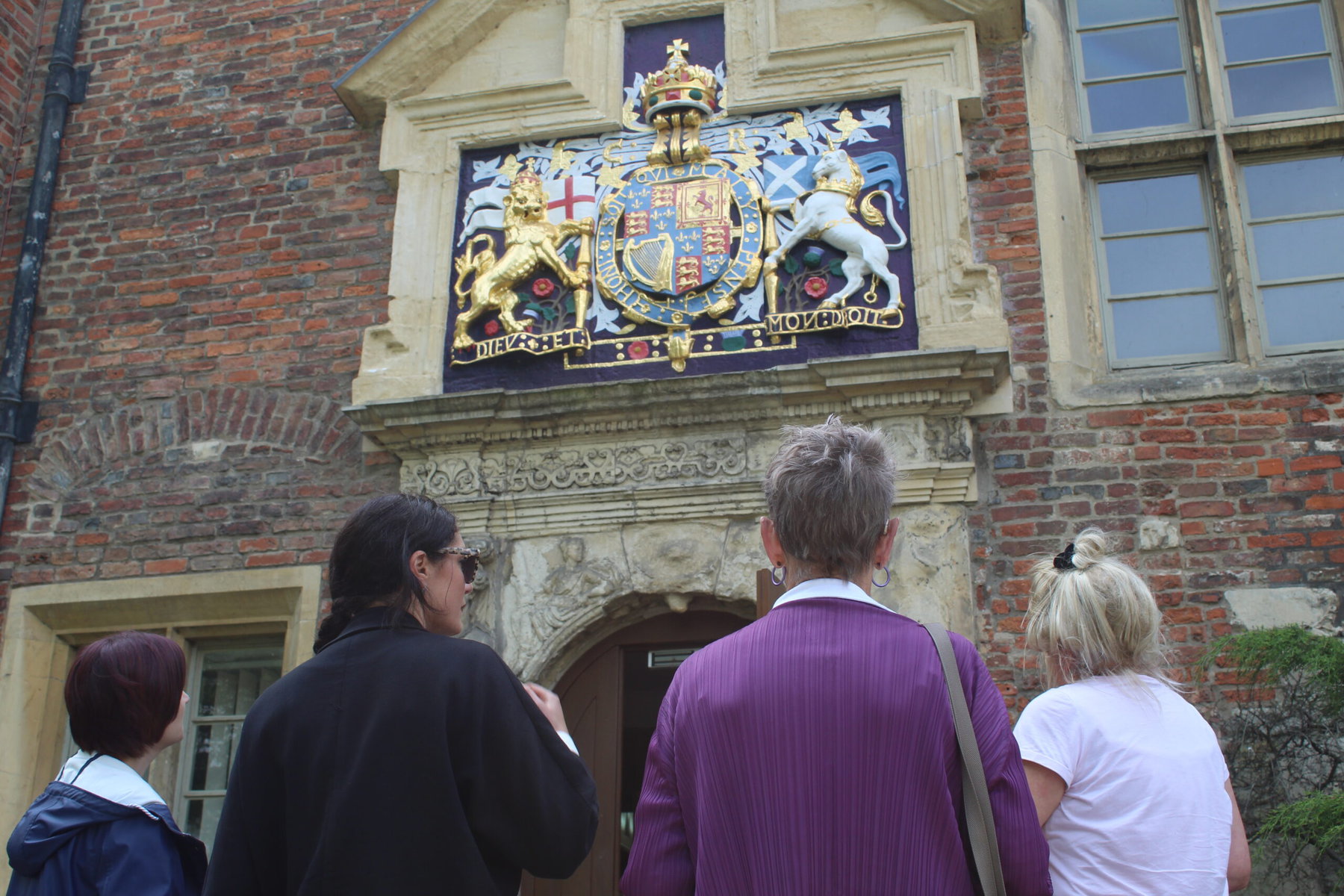 An Invisible Cities tour in York. Courtesy of Invisible Cities
An Invisible Cities tour in York. Courtesy of Invisible Cities
“I love being able to share the underbelly of our city, because York is very much seen as a vibrant city that’s rich with history and architecture. But I bring in aspects of rough sleeping, addiction and recovery, and I share what’s actually going on when [it’s] relevant, which keeps it alive for me, because it’s ever-changing,” he says.
Through other volunteering Miles has also built relationships with universities in the area, which have made his tour part of the curriculum for social policy students. He’s even had doctors come along who say they’ve gotten more out of it, in terms of understanding the city’s social support structure for homelessness and addiction, than a formal training day, so he is in talks with a number of local clinics to encourage more medical professionals to attend.
Founder Zakia Moulaoui Guery initially came up with the idea to help formerly homeless people gain the confidence to embrace the next chapter of their lives. To spread the concept of Invisible Cities further across the country, Moulaoui Guery has since developed a social franchise model, partnering with existing homeless organizations, which then take on the recruiting and training of guides.
This is crucial, says Moulaoui Guery, so the operation can continue to expand in a way that stays true to its mission of leveraging tourism to shine a light on issues of social justice and inequality, and help do good with the money visitors bring to iconic UK cities. Invisible Cities Cardiff, for example, is in partnership with The Wallach, the largest homelessness charity in Wales.
Courtesy of Invisible Cities
Invisible Cities guides are trained to give unique tours that weave together the city's history and their own personal story.
“Finding the right partner on the ground is always more important than whether or not that city will work in a touristic way,” says Moulaoui Guery. “I would rather work with a trusted partner, and for it to be a bit harder in terms of visitors, than to go somewhere like London, for example, which would be a lot harder to make work.”
In this way, expansion to Liverpool and the Scottish Borders is currently in the works. Moulaoui Guery is also eyeing cities like Oxford, Cambridge, Aberdeen and Dundee.
Not all who take on Invisible Cities’ training become guides — just 16 are currently actively running tours. About a quarter of a training cohort of around eight people become guides, shares Moulaoui Guery, while another quarter stay involved with Invisible Cities in a different capacity, for example, helping at tourism trade shows. Another quarter take up a different opportunity, through a job or setting up their own venture. And another quarter move on without staying in touch.
 Zakia Moulaoui Guery, founder of Invisible Cities. Courtesy of Invisible Cities
Zakia Moulaoui Guery, founder of Invisible Cities. Courtesy of Invisible Cities
As much as she’s passionate about spreading the Invisible Cities movement, Moulaoui Guery is just as happy when guides move on.
“I think sometimes it’s great when we don’t hear anything from people, because it means they are moving on, and are too busy living out their dreams. What we don’t want to do is hold onto people forever,” she says.


Become a sustaining member today!
Join the Reasons to be Cheerful community by supporting our nonprofit publication and giving what you can.
Miles, meanwhile, is not only sober and in his own apartment, but has also helped set up another nonprofit organization to tackle homelessness and poverty. In light of his new commitments, he has gone from doing several Invisible Cities tours a week to a handful a month — but is keen to stay active as a guide even in this capacity.
“I don’t want to stop doing the tours,” he says. “They are really enjoyable. I will still keep this as a precious thing, because we are a close-knit team and really support each other. There’s quite a family feel.”
The post On ‘Alternative Walking Tours,’ Formerly Homeless People Share Their Perspectives appeared first on Reasons to be Cheerful.
The Grandmas and Grandpas Brewing Beer in Vienna
In the maze of neon-lit corridors beneath a senior home on the southwestern outskirts of Vienna, the warm scent of malt leads to a small room that’s become the headquarters of an unlikely microbrewing success story. A colorful mural on the wall depicts five residents of the home enjoying a pint, and beneath, three of them are pitching in on today’s brewing efforts.
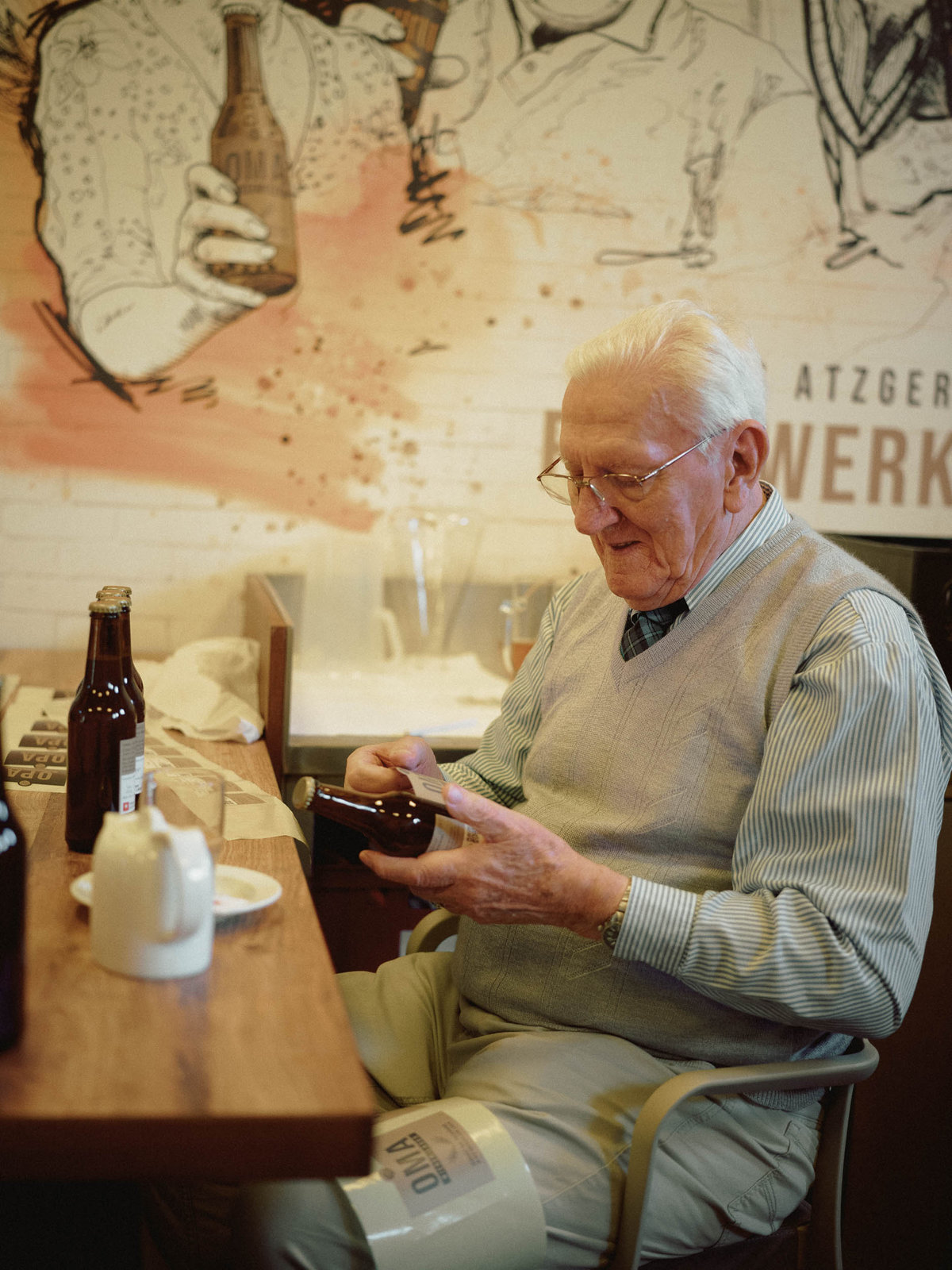 Gustav Paier labeling bottles. Credit: Andreas Jakwerth / Häuser zum Leben
Gustav Paier labeling bottles. Credit: Andreas Jakwerth / Häuser zum Leben
Helmut Riegerbauer always comes in early, and by the time the others have joined he’s already pulled on purple latex gloves and moved to the manual bottle capper. “He’s the only one who gets to wear an official apron,” quips Gustav Paier, himself neatly dressed in a colorful cable-knit sweater. “You have to earn it,” winks Helmut, smoothing the dark green apron emblazoned with the word Brauwerkstatt.
And earn it he does — in the course of the morning he caps around six cases of freshly filled beer bottles, careful to add a tab of priming sugar to each. Occasionally he comes to check on his friends, who are busy with labeling. “I’m the controller,” he explains, swiftly scanning a case and pulling out a bottle missing the back label. Rupert Jaksch, who has taken up his usual position at the end of the table, quickly puts on the missing label for their Viennese lager, called Opa and Oma — Grandpa and Grandma.
The lager was the first beer the Brauwerkstatt in Haus Atzgersdorf started brewing in the summer of 2020, when the Covid lockdowns made life in the senior home especially lonely. The home’s previous director came up with this unusual plan to bring the residents together and give them a meaningful way to spend their time. Helmut, Gustav and Rupert have been part of the project from the start and have become fast friends. They’re all firmly in their 80s, with Rupert the oldest at 88, but the laughter and easy banter make the atmosphere in the room feel unusually festive for a Thursday morning.
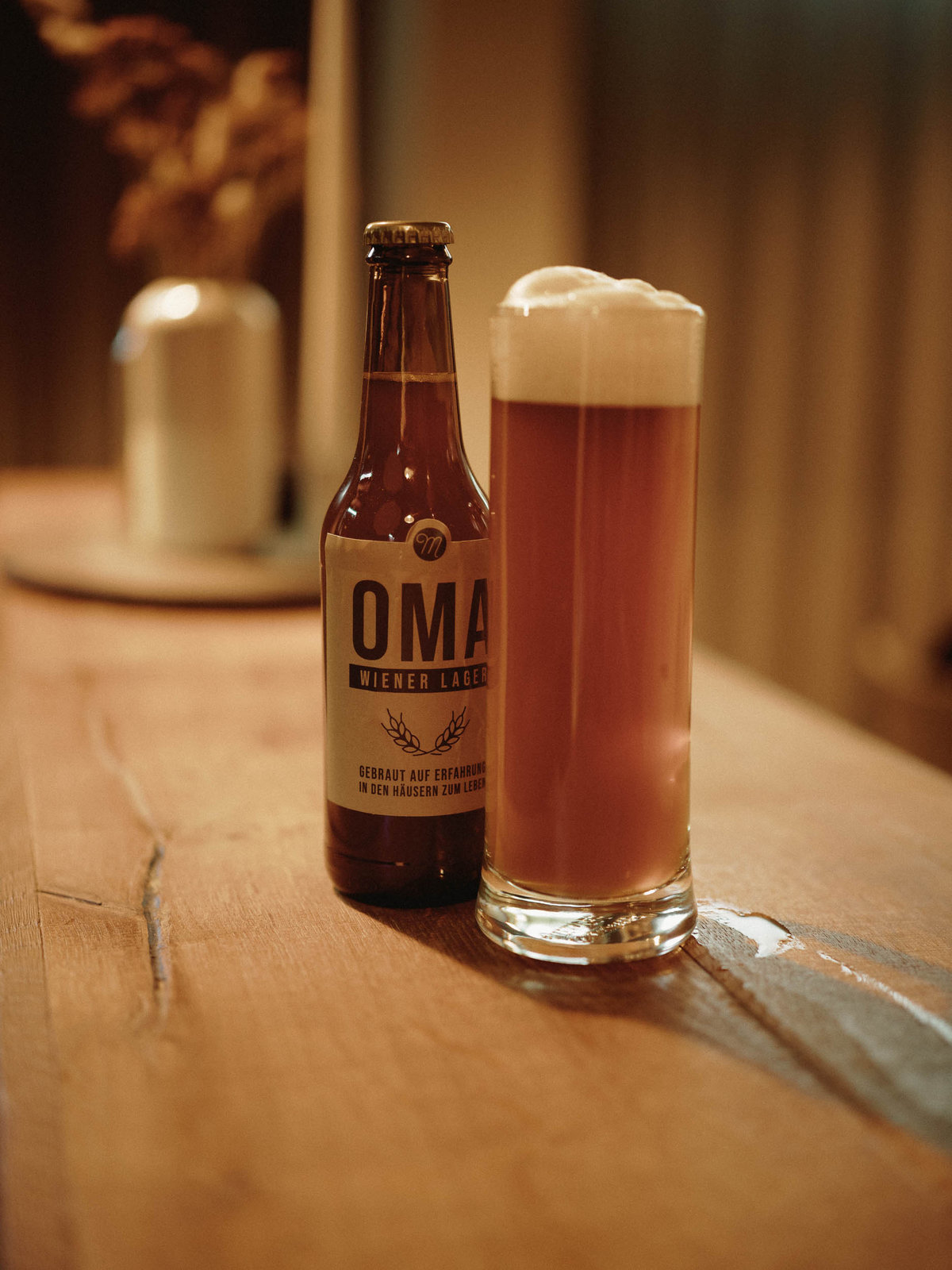 A bottle of Oma (“grandma”) Viennese lager. Credit: Andreas Jakwerth / Häuser zum Leben
A bottle of Oma (“grandma”) Viennese lager. Credit: Andreas Jakwerth / Häuser zum Leben
What started as an off-the-cuff idea has since become a successful microbrewery that can barely keep up with demand. In 2023 the Brauwerkstatt doubled its brewing capacity to 12,000 bottles annually and is planning to double it again this year. The senior home staff takes care of the more physically demanding aspects of the work, but Bernhard Wittholm, a trained beer sommelier who joined the team last year, recognizes that the heart of the project lies elsewhere: “It’s not really about brewing beer but about companionship. The residents have a lot of stories to tell, and it’s good for them to get out of their bubble. You notice that they blossom when they’re here.”
Including the senior residents in the project was crucial from the start, says the home’s director, Christian Ehm: “They’re involved in the whole production process, from brewing to bottling, packaging, a bit of advertising … and drinking.” He laughs. “Doing something you enjoy also keeps you fit and alive.”
Haus Atzgersdorf is one of the 30 Häuser zum Leben (Houses for Living) in Vienna run by KPW, a nonprofit that also includes 150 senior clubs in the city, making it the largest provider of senior care in Austria. While the Brauwerkstatt is one of its most visible projects, a full event calendar ranging from yoga to clown workshops ensures that the seniors in these homes remain active and connected. “We want to change the idea that being old has to be something tragic and passive. We’re convinced that older people have a lot to offer if you give them the right framework,” says KPW spokesperson Hans Grasser.
Credit: Andreas Jakwerth / Häuser zum Leben
The Brauwerkstatt is a place where seniors find companionship and a sense of purpose. It's also a successful brewery.
With the world population aging at an accelerated pace, finding ways to help people thrive in old age is becoming an increasingly pressing concern. In 2020, the World Health Organization launched the Decade of Healthy Aging to spearhead a sustained global effort to improve the lives of seniors. That same year, people over 60 years old outnumbered children under five years old for the first time in history, and by 2050 their number is expected to double to 2.1 billion. Healthy aging is about more than mobility and blood pressure — we are social animals, and social isolation and loneliness have been shown to significantly increase the risk of mental and cognitive decline, physical health conditions such as cardiovascular disease and stroke, and early death.
Crushed by negative news?
Sign up for the Reasons to be Cheerful newsletter.
[contact-form-7]
Increasingly, cities are recognizing the need for a systemic and comprehensive approach to tackling the challenges of an aging population. The German city of Arnsberg launched its Department of Future Aging in 2004, Barcelona announced a plan to become a “senior-friendly city” in 2022 and Vienna, where a quarter of the residents will be over 60 by 2030, has a dedicated “Vienna for seniors” team working on a broad range of topics, from living with dementia to an event-filled Seniors’ Month every October.
Credit: Sarah Bruckner / Häuser zum Leben
Activities at Vienna's Häuser zum Leben (Houses for Living), including yoga, help residents stay active and connected.
While the seniors at Brauwerkstatt found their calling in beer, others have a second career in baking. Vollpension, a popular café and social business in central Vienna, employs “grandmas” (and the occasional “grandpa”) to bake cakes according to their own time-tested recipes. More than half of the 80-strong team is over 60 years old, many of them living alone. Beyond bringing them into regular contact with colleagues and customers of all ages, their work at Vollpension on average increases their monthly income by 40 percent — no small feat in a country where the average woman’s pension is 37 percent lower than a man’s.
Other “grandmas” prefer to devote their time to childcare. For over 50 years the Omadienst (“Grandma service”) has been matching older women in Vienna with families in need of a grandma-like figure to help with childcare. There are some 400 Leihomas (“grandmas-for-hire”) currently active in Vienna, estimates Andrea Beer, who leads the project: “Often they take care of the kids from when they’re babies until they’re in high school, and remain in contact long after they no longer need babysitting.”
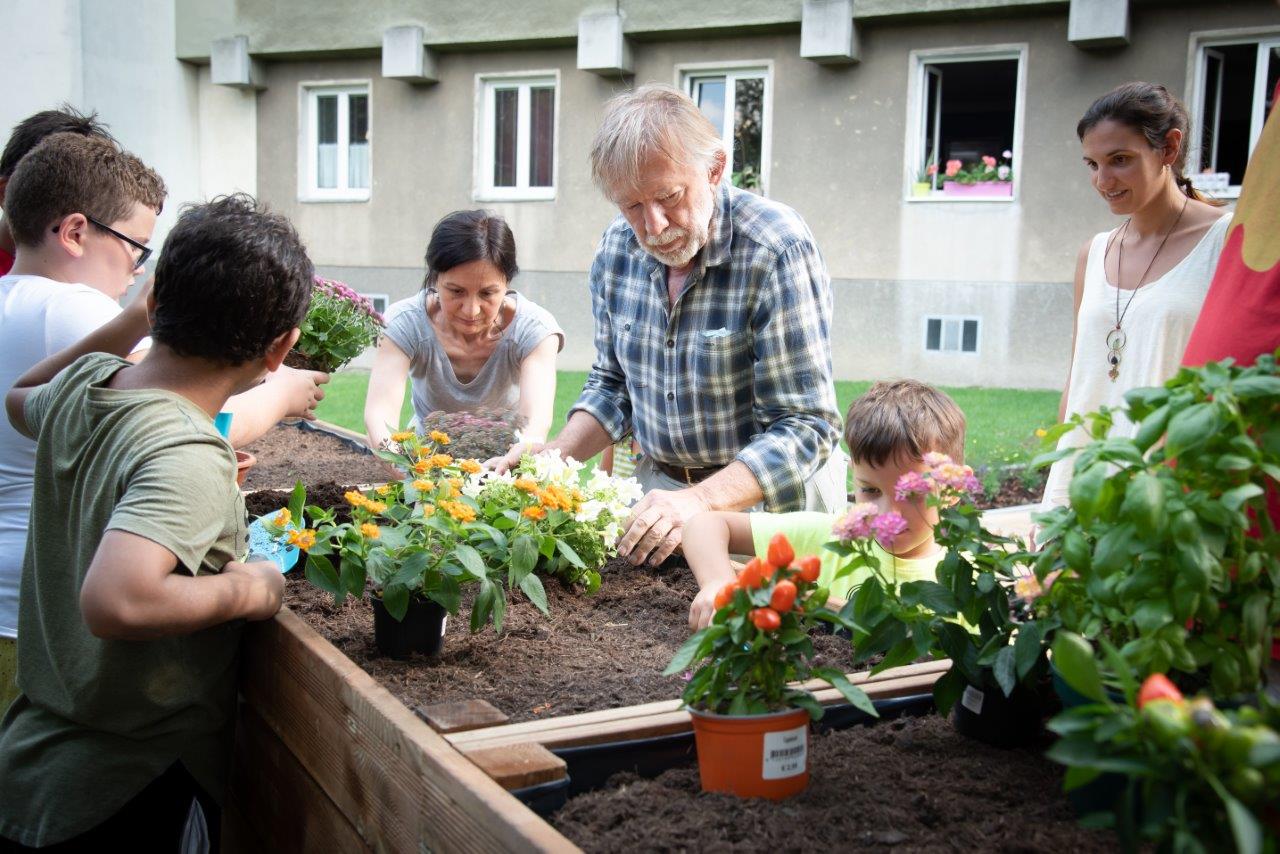 Seniors and children gardening together at the Hofferplatz intergenerational meeting point. Credit: Sarah Bruckner / Häuser zum Leben
Seniors and children gardening together at the Hofferplatz intergenerational meeting point. Credit: Sarah Bruckner / Häuser zum Leben
A number of Viennese senior homes also house kindergartens, a practice that is proving popular worldwide, from Seattle to Singapore. Taking it a step further, some senior homes are also becoming a hub for intergenerational living, solving two problems at once: the struggle of finding affordable housing facing many young people, and the social isolation experienced by seniors. As part of a Young Living program, 50 apartments in the various Häuser zum Leben senior homes are earmarked for students, who contribute 25 hours of volunteer work per month in exchange for affordable rent. At the Humanitas retirement village in the Netherlands six students are living rent-free, offering company and support to their senior neighbors. In the US, a number of colleges partner with senior care facilities to create intergenerational housing solutions, while so-called University-based Retirement Communities (UBRCs) combine senior living with access to university courses and campus facilities for seniors.


Become a sustaining member today!
Join the Reasons to be Cheerful community by supporting our nonprofit publication and giving what you can.
Back in the brewery, the seniors are joined by Lukas and Andy, high school students who are doing a two-week internship at the senior home as part of Compassion Project, a social learning initiative. Rupert is showing them how to label the beer bottles. Keeping the labels straight and smooth is not as easy as it seems, but after almost four years of weekly practice, he’s a pro. From the handle of his wheelchair hangs a black felt bag emblazoned with the motto “the Beauty and the Beer,” a present from his daughter. “This here is our second life chapter,” he says. “And we’re happy to still be needed.”
The post The Grandmas and Grandpas Brewing Beer in Vienna appeared first on Reasons to be Cheerful.
Does the Right Even Know Why it’s so Threatened by Taylor Swift and Travis Kelce?
Stop the presses! If you’ve been living in a neighboring cave, you too will know...
How a Feminist Blog is Born
I didn’t deign to call myself a feminist until I was nineteen years old, in my second year of college. Before then, I just wanted to be a writer. Reading Judy Blume and the Baby-Sitters Club books obsessively as a kid, I decided I wanted to be an “author” when I grew up, and started writing my own poems and young adult novels in fourth grade (a baby poet at heart, I could never get past chapter…
The School Day When No One Eats Alone
Laura Talmus felt helpless when her then-11-year-old daughter Lili kept calling her from school in tears. “It’s pretty nerve-racking when you’re getting phone calls from your daughter who’s just crying and begging you to come pick her up from school,” Talmus remembers. “The lunch breaks were the hardest.” After trying some interventions in the school with little success, Talmus and her husband Ace Smith eventually decided to homeschool Lili with private tutors.
Lili Rachel Smith was born with Apert syndrome, a rare genetic condition that made her look different and contributed to her feeling invisible and left out at school. According to her mom, she was not bullied by her classmates and did have some friends. “But in sixth grade, the kids sent the message by turning their backs in the cafeteria to let her know she wasn’t welcome to join them at their table,” Laura Talmus says, describing what she calls “the terrible social atmosphere” at the school. “Lili spent most lunch breaks hiding in the library or the bathroom stalls, eating lunch by herself.”
After her daughter passed away from medical complications in her sleep at age 15 in 2009, Talmus put together a video celebrating her life. When she showed the video, Lili’s classmates were shocked to realize how isolated Lili had felt, and Talmus understood that a lot of kids felt disconnected like her daughter had: “I was absolutely blown away when I saw how many kids raised their hands and wanted to talk about how they felt isolated.”
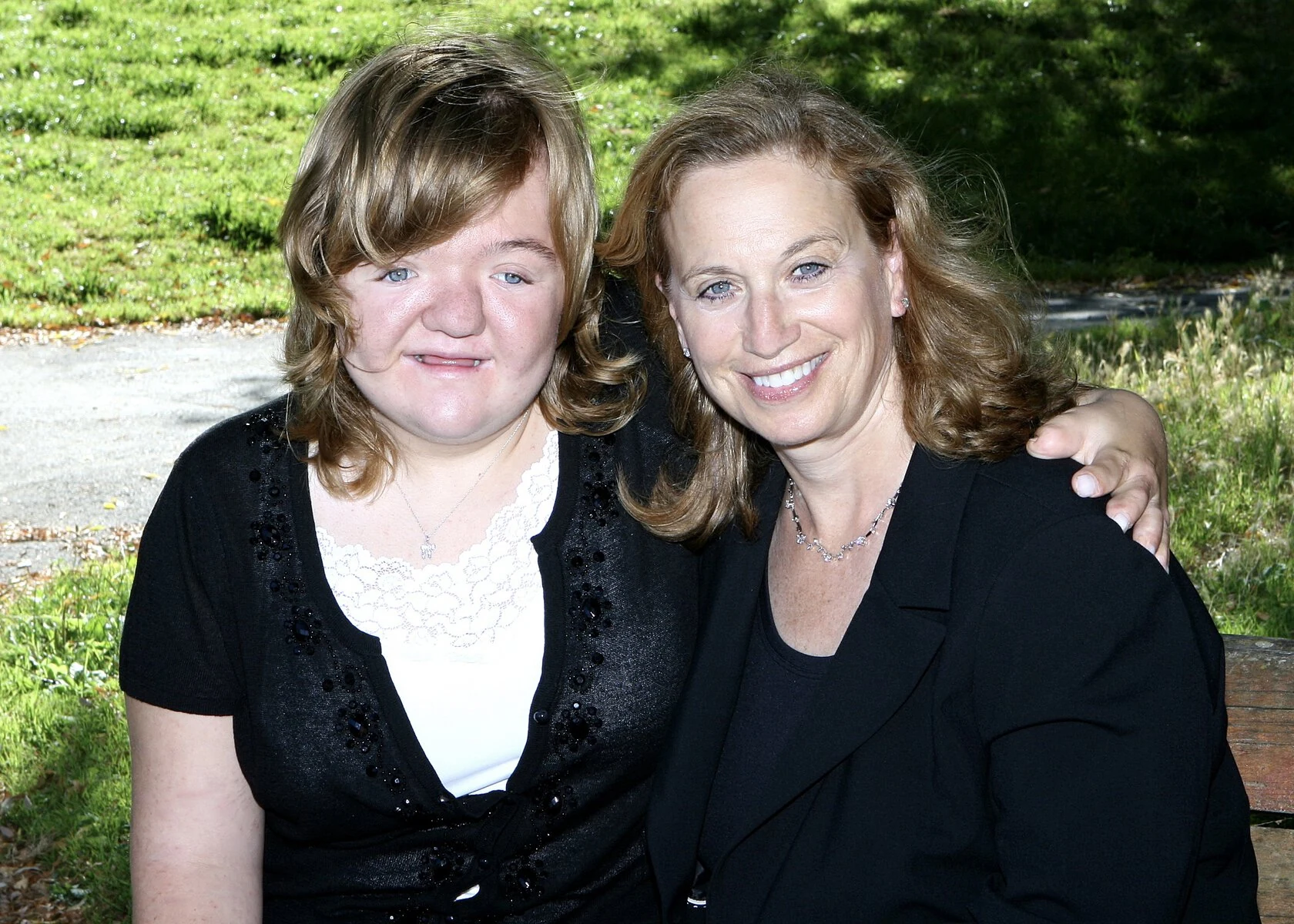 Laura Talmus with her daughter Lili, who passed away at age 15. Courtesy of Beyond Differences
Laura Talmus with her daughter Lili, who passed away at age 15. Courtesy of Beyond Differences
The next year, Talmus, a professional fundraiser, and her husband channeled their grief into forming Beyond Differences, a nonprofit that focuses on raising awareness about social isolation in youth and providing solutions. Since that time, the need has only become more clear: US Surgeon General Vivek Murthy raised the alarm last year when a study found rates of loneliness reported among young adults have risen every year for more than a decade. Teenagers spent nearly 70 percent less time hanging out with friends in person in 2020 than they did in 2003 (down from 150 minutes a day two decades ago to 40 minutes a day). The study notes that the Covid-19 pandemic accelerated the trend.
Talmus believes the social isolation her daughter experienced is affecting students all over the country and contributing to serious health issues, mental health problems, suicide and school violence: “They have trouble connecting, trouble feeling safe.” Beyond Differences started with Lili’s school and four other schools in California’s Marin County, where the family lives, but has now grown to reach over one million students in all 50 states.
Crushed by negative news?
Sign up for the Reasons to be Cheerful newsletter.
[contact-form-7]
On February 16, 2,500 schools in all 50 states will participate in No One Eats Alone Day, a day of action created by Beyond Differences that encourages fifth through eighth graders to mingle, make new friends and become more aware and proactive about social isolation, especially at lunch.
“No One Eats Alone is completely rooted in the experience Lili had,” Talmus explains. “For many children, the lunch break or recess are the worst parts, so we started with that.” Beyond Differences sends backpacks or “Belonging Boxes” with a lesson plan, games, toys, art projects, stickers and conversation starters to participating educators, at no cost to the schools. Conversation starters could revolve around sports, video games or food, or be playful icebreaker questions like, “Would you rather have scales or fins?”
“The best [part] is that it’s intended to be led by students for other students,” Talmus says. “This is about making inclusion a little bit more cool and acceptable. All tides lift boats.”
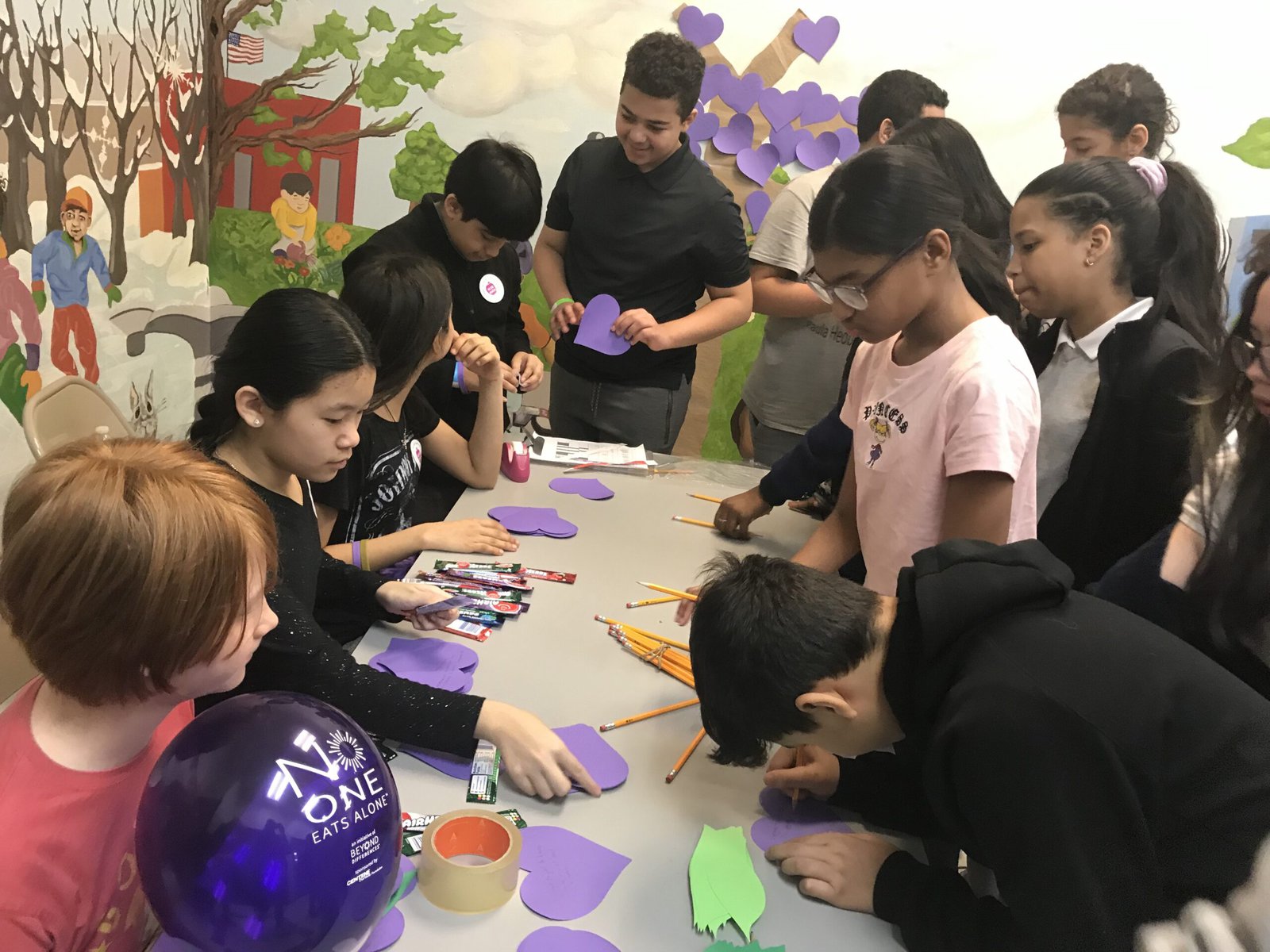 Schools in all 50 states participate in No One Eats Alone Day. Courtesy of Beyond Differences
Schools in all 50 states participate in No One Eats Alone Day. Courtesy of Beyond Differences
Crucially, the curriculum has been partially developed by slightly older peers, a group of 36 high school-aged student leaders across the country who form the nonprofit’s National Teen Board. “Their mission about ending social isolation in schools really struck me,” says Paarth Sharma, an eloquent 16-year-old high school student from Portage, Michigan, who has been on the Teen Board since November 2022. “A lot of the curriculum they develop is what I would have loved to have when I was in middle school.” Sharma believes his engagement in the nonprofit has made him able to better identify social isolation and be more inviting, for instance, when a new student joins his school.
Kids participating in No One Eats Alone Day this year will play an artsy game called “Let’s Grow” that Sharma helped develop: “It’s an art kit with elements like flowers, stems and clouds that the kids can write on,” he explains. “The flowers represent things that make them shine, the stems things that build them up, the roots can be things that make them grow, and the clouds represent something they struggle with.” In the end, the teacher will tape the contributions together as a “garden” that represents the seeds of connection and the potential of growth.
Sharma chose the “queer visibility” section of the national curriculum as his focus. In their monthly Zoom meetings, the teenagers on the board talk about strategies to make sure school libraries carry books that are written by LGBTQ+ authors and feature LGBTQ+ characters as well as how to educate teachers and administrators and ways students can safely express their identity in conservative states.
“No One Eats Alone cuts across all those lines whether or not your state requests or requires teachers to teach social and emotional learning or health education,” Laura Talmus says. “There has never been a case where anybody said, ‘You can’t bring No One Eats Alone to our school or our state.’”
 A Belonging Box for this year’s No One Eats Alone Day. Courtesy of Beyond Differences
A Belonging Box for this year’s No One Eats Alone Day. Courtesy of Beyond Differences
With support from the New York City Department of Education, 10 New York schools measured the impact of No One Eats Alone in 2019 and found that key indicators, including “awareness of social isolation, frequency students intervened when they saw social isolation, student leadership, youth voice, and social emotional learning all increased significantly from beginning to end-of-year for seventh grade students who attended three or more Beyond Differences events.”
One principal quoted in the study says: “Beyond Differences has made an impact on our school community and fostered more student voice. Students are more aware that they can intervene when bullying issues come up in the school, and they are also more careful about using technology in a positive manner.”


Become a sustaining member today!
Join the Reasons to be Cheerful community by supporting our nonprofit publication and giving what you can.
Two other programs, Know Your Classmates and Be Kind Online complement the lunch initiative. Classes can start in the fall with the Know Your Classmates program, which creates activities to help kids eliminate barriers to getting to know one another and understand others’ cultures, identities and stereotypes. And Be Kind Online “educates children about social media, identifies online behavior that leads to social isolation and creates opportunities for kids to engage positively with one another,” Talmus explains.
Talmus is convinced that the pandemic lockdowns made the initiatives more needed than ever. “I do believe that children are feeling less safe,” she says, and refers to a recent study that found 71 percent of children are still struggling with the return to school since the lockdowns. “There is absolutely no easy place in America for children to be growing up right now.”
She feels that she is honoring Lili’s life by starting a national movement, enabling students to “just even take that first step to get to know somebody that they normally don’t sit with,” she says. “I have seen so many friendships blossom.”
The post The School Day When No One Eats Alone appeared first on Reasons to be Cheerful.
What Did Afong Moy Dream About?
The first documented Chinese woman to come to the United States was told it would be temporary. Just 19 years old (or 14, or 16—reports vary), Afong Moy was brought to America not as an immigrant, but as a curiosity, sold off by her father to a ship captain who promised he would return her on his next voyage back to Canton in two years. Moy’s father wouldn’t be the only one to capitalize off…
Music in Schools: A Plea
If you went to a state school in the 20th Century and had an interest in or aptitude for music, the chances are you went to a Saturday morning music school run by your local authority, played in your county youth orchestra, band or other ensemble, participated in one of its choirs, and received specialist tuition (often free) in playing or singing.
Like tens of thousands of others, my siblings, cousins, and I all benefited from the Oxfordshire County Music Service. At one point there were five Goodalls in the orchestra. Some of the County Music Services were world class, but even the smaller ones offered a safety-net provision for children who wanted to play instruments, whether or not the local authority school they individually attended had a flourishing music department of its own.
After the change of government in 2010, these services were transformed into 'Hubs'. Part of the rationale for this was that young people’s experience of and engagement in music, in the new century, was itself changing and it was felt that providers from outside the classical orchestral tradition could add a new dimension to the offer. There was a political aspect to the change, too.
Under then Education Secretary Michael Gove from 2010 onwards, the Government’s policies moved to loosen local authorities’ grip on schooling at an accelerated pace, with the diverting of funds earmarked under Labour for the rebuilding, maintenance and renovation of all schools, to the setting up of so-called ‘free schools’ that would answer only to the Secretary of State, in effect independent but taxpayer-funded.
So it was with the replacement of County Music Services to the Hubs which followed a hybrid model, combining local authority involvement (or not) with private sector organisations, businesses and some musical charities.
The mantra that state-provided services were always necessarily worse than anything the private sector could offer reshaped government policy (see also: public utilities and infrastructure, social housing etc.). The Hubs came into existence and set about their task, by and large, with aplomb.
Then, in June 2022, the Government announced its intention to reduce the number of Music Hubs nationally from 116 (roughly analogous to the county music service network they replaced) to 43, effective this year, in April, theoretically. This came after, and in direct contradiction of, consultation in the sector and analysis of the data received from the Hubs over their 10-year existence that this would be the worst of all given options for a restructuring of the network.
In the final year of the last Labour Government, funding for the County Music Services ran at £82 million annually, a figure that the incoming Coalition Government pledged to match, which it nearly did (£79 million) – a figure that remains today. Yet £80 million in 2010 is equivalent to £120 million in 2024, so the continued grant of £79 million is not only, in real terms, a significant cut, but the Government is now asking, for this same £79 million, for 43 Hubs to do the work and reach of the 116.
There is not one shred of evidence that the slimming down of the provision network will improve anything. The reduction of Hubs is a cost-cutting exercise dressed up as rationalisation. Nothing about this change will help a single child’s participation in music, though much in the National Plan for Music Education, of which it was a part, was welcomed, outlining as it did a strong case for musical opportunities and pathways to be made available to all children in English schools.
The transforming of the County Music Services into Hubs coincided with Gove’s radical overhaul of the national curriculum at the Department for Education. Gove was warned by almost everyone involved in cultural education that his pet project – what became the English Baccalaureate (EBacc) – would decimate creative subjects in state schools. His department ignored this advice (he and Dominic Cummings haughtily described the educators who challenged their reforms as "the Blob") and went ahead with the five-subject scheme.
Sure enough, since its introduction (and that of its bedfellow, Progress 8 assessment), the uptake of GCSE Music has dropped from 7% of the overall cohort to 4% of the cohort. The drop at 'A’ Level Music is of a similar magnitude. Ditto other arts subjects. These are stark figures.
We are heading, at this rate, back to the situation in the early 1960s when only 5,000 children annually took 'O’ Level Music, virtually all of them in grammar and private schools. The huge steps in access and opportunity in the arts for young people that took place thereafter, especially between 1997-2009, which included funding of new resources and classroom teaching of music technology, have been put into reverse.
Why does it matter how many children take music or music technology as a classroom subject, if they can play in an orchestra or sing in a choir, politicians ask (Gove said this to me at a lunch in 2009 before he did all this).
The reason it matters is that, unlike in independent schools, which can afford members of staff to run extra-curricular musical activities whether or not they teach classes, state schools, by and large, fund teachers according to the numbers of children studying a subject in publicly examined classroom subjects. If you are at a school with few or no children taking GCSE or 'A’ Level music, there simply won't be the staff to organise and run all the other myriad musical activities that every fee-paying school in the country considers essential to attract parents.
If you rank schools by results, as state schools are by Ofsted, according to how well you deliver the five EBacc subjects, giving scant or no recognition to everything else a school might offer, you will inevitably see a decline in ‘non-essential' subjects.
What happened to music education between 2010 and 2022 was a root-and-branch dismantling of a model that expected schools to include music just as they would any other subject.
Historically, there were two types of music education offered in advanced economies in the post-war period. Three, if you include Finland (but Finland is so far ahead on its own in educational enlightenment and high standards that it’s unfair to compare it to other countries).
On the one hand, for example, Germany and France, have not traditionally offered much music inside non-specialist secondary schools but created well-resourced music schools in every town or neighbourhood for use at weekends, and after school, with highly subsidised or even free tuition. These local centres also offer the opportunity to be part of ensembles or choirs.
The UK, on the other hand, developed a different tradition where music in schools would involve the option of studying the subject in class to GCSE/'A’ Level and also a range of extra-curricular musical opportunities on site. Many states in the US persist with this model too, where you would expect considerable musical endeavour to be going on in a high school without the need for children to look for these activities elsewhere.
The County Music Service network was set up specifically to support and enlarge what individual state schools in the UK offered, not to replace provision in schools. Most if not all children accessing the County Music Services network did so through their schools.
The National Plan of 2022 intended to change the dynamic of this arrangement so that the Hubs would now be wholly responsible for ensuring schools in their area complied with the check list of requirements the Government expected them to provide for their students. No additional funding was found to pay for this considerable new burden of responsibility, and the plan's stipulation that schools in England teach all five to 14-year-olds one hour of music a week has no statutory enforcement, nor are there any sanctions for schools' failure to comply.
The Conservatives’ agenda seems to be to hand over the state’s responsibility for music education to independent organisations, outside schools, but with a decreasing level of funding so to do. This feels like a recipe for further decline in music as a classroom subject or extra-curricular activity in any school that does not right now have an outstanding music department, well supported by its senior leadership team.
What worries me about all this is that it is a no-brainer for a fee-paying school to offer plentiful access to musical engagement for its students. It is assumed that parents want this for their children and that there are huge benefits for a learning community that has plenty of music going on within it.
So why must it be such a struggle for the same assumption not to underpin a government providing a rounded education to the children in its care in state schools? Why is it always a matter of how cheaply it can be done? Why can't 93% of our children in state schools receive the same musical offering that the 7% children in private schools take for granted? If it's a good thing for the 7% it's a good thing for the 93%, is it not?
The signal from the Government, time and time again, is that creative subjects are non-essential. Which is weird for a country that has congratulated itself, for the past 40 years at least, for being the world’s second-biggest provider of music after America.
There is now a drastic shortage of teachers in arts subjects. The Department for Education met only 27% of its target for newly-trained music teachers last year. ’Please come and teach a subject we don't value, nor will your school get Ofsted credits for you offering excellent music’ is not exactly the welcoming slogan to a career in music teaching they may think it is.
Headteachers are already under enormous pressure, financially, and may be tempted by governmental uninterest to see reducing musical facilities as a way of saving costs in hard times. Some may think, erroneously, the Hubs will have new money to do the job for them.
Rishi Sunak recently revealed his back-of-an-envelope priority for education – that all children up to the age of 18 should take mathematics. It is an idea that seems detached from our current, urgent reality. How will it address our shortages of health workers, revive our hospitality sector, solve the food security crisis unfolding across the agricultural landscape? How do we avert the worst effects of environmental catastrophe?
All of the above will require ingenuity, teamwork, imaginative thinking, resourcefulness – how are those qualities taught and acquired? How do we help young people to be more open-minded, creative, and community-minded in a period of enormous insecurity and social dislocation? To question, explore, take risks? To perform, to be more confident, to think differently, and to value difference? How do we improve young people’s well-being and mental health?
One answer to these questions is engagement with music and the other arts, from a young age, as part of a rounded, transferable-skills-orientated education. I am pretty sure extending any individual subject, however laudable in its own right, is not the cure. Sunak reinforces the notion that there are ‘essential’ school subjects, and the rest are add-ons, luxuries, agreeable perks.
And, if his idea was solely about our economic future, then riddle me this: what percentage of ‘mathematical’ jobs currently undertaken by accountants and fund managers will be replaced by artificial intelligence in the next 20 years – 80%? 90%?
I’ve met several Conservative MPs who were enthusiastic supporters of the arts in general and of music education being available to young people in particular. They have gone deathly quiet in recent years. Perhaps they were removed in the Great Brexit Purge of 2019. Perhaps they are afraid of being slapped down by libertarian asset-strippers and ultra-nationalist populists, now ascendant in their party, who think the words of Rule, Britannia! or statues of slavers are what constitute our country’s ‘culture’.
In recent years, we have had to listen to a Deputy Prime Minister no less, Dominic Raab, snobbishly mocking Angela Rayner for going to the opera to see Mozart’s The Marriage of Figaro, and a constant stream of disdainful, ill-informed 'culture warriors’ who cannot conceal their distaste for the people who make art and the institutions, like the BBC, that nourish it.
Britain’s two biggest and most essential exporting industries, by a wide margin, financial and creative, were two sectors conspicuously left out of Lord David Frost’s Trade and Cooperation Agreement withdrawal deal with the EU. For us, in music, that shoddy, negligent negotiation led to a 'no deal’ Brexit. How valued we felt. By our own Government. It fits a pattern that has emerged in the last decade of neglect, bordering on contempt.
A lot of hope in the music and education worlds is being pinned on an incoming Labour government, enhanced by the fact that the Shadow Secretary of State for Culture, Media and Sport, Thangam Debbonaire, is herself an accomplished musician.
Both she and Labour Leader Keir Starmer have spoken forthrightly about the need to restore music and other arts to their place in schools in England and Wales. The weight of expectation on a new government, if elected, will be to find quick fixes to problems that have been years, or even decades, in the making, with a gigantic national debt and public sector funding crises everywhere you look. Right now, there are nine million children of school age in England, and the current funding for music services that support them in school, the Hubs, get £79 million a year from government. That’s less than £9 per child, per year.
Don’t our children deserve better than this?
King of the Extrinsics
The deep and crucial reason why Trump could win again.
By George Monbiot, published in the Guardian 29th January 2024
Many explanations are proposed for the continued rise of Donald Trump, and the steadfastness of his support, even as the outrages and criminal charges pile up. Some of these explanations are powerful. But there is one I have seen mentioned nowhere, which could, I believe, be the most important: Trump is King of the Extrinsics.
Some psychologists believe our values tend to cluster around certain poles, described as “intrinsic” and “extrinsic”. People with a strong set of intrinsic values are inclined towards empathy, intimacy and self-acceptance. They tend to be open to challenge and change, interested in universal rights and equality, and protective of other people and the living world.
People at the extrinsic end of the spectrum are more attracted to prestige, status, image, fame, power and wealth. They are strongly motivated by the prospect of individual reward and praise. They are more likely to objectify and exploit other people, to behave rudely and aggressively and to dismiss social and environmental impacts. They have little interest in cooperation or community. People with a strong set of extrinsic values are more likely to suffer from frustration, dissatisfaction, stress, anxiety, anger and compulsive behaviour.
Trump exemplifies extrinsic values. From the tower bearing his name in gold letters to his gross overstatements of his wealth; from his endless ranting about “winners” and “losers” to cheating at golf; from his extreme objectification of women, including his own daughter, to his obsession with the size of his hands; from his rejection of public service, human rights and environmental protection to his extreme dissatisfaction and fury, undiminished even when he was president of the United States, Trump, perhaps more than any other public figure in recent history, is a walking, talking monument to extrinsic values.
We are not born with our values. They are shaped by the cues and responses we receive from other people and the prevailing mores of our society. They are also moulded by the political environment we inhabit. If people live under a cruel and grasping political system, they tend to normalise and internalise it, absorbing its dominant claims and translating them into extrinsic values. This, in turn, permits an even crueller and more grasping political system to develop.
If, by contrast, people live in a country in which no one becomes destitute, in which social norms are characterised by kindness, empathy, community and freedom from want and fear, their values are likely to shift towards the intrinsic end. This process is known as policy feedback, or the “values ratchet”. The values ratchet operates at the societal and the individual level: a strong set of extrinsic values often develops as a result of insecurity and unfulfilled needs. These extrinsic values then generate further insecurity and unfulfilled needs.
Ever since Ronald Reagan came to power, on a platform that ensured society became sharply divided into “winners” and “losers”, and ever more people, lacking public provision, were allowed to fall through the cracks, US politics has become fertile soil for extrinsic values. As Democratic presidents, following Reagan, embraced most of the principles of neoliberalism, the ratchet was scarcely reversed. The appeal to extrinsic values by the Democrats, Labour and other once-progressive parties is always self-defeating. Research shows that the further towards the extrinsic end of the spectrum people travel, the more likely they are to vote for a rightwing party.
But the shift goes deeper than politics. For well over a century, the US, more than most nations, has worshipped extrinsic values: the American dream is a dream of acquiring wealth, spending it conspicuously and escaping the constraints of other people’s needs and demands. It is accompanied, in politics and in popular culture, by toxic myths about failure and success: wealth is the goal, regardless of how it is acquired. The ubiquity of advertising, the commercialisation of society and the rise of consumerism, alongside the media’s obsession with fame and fashion, reinforce this story. The marketing of insecurity, especially about physical appearance, and the manufacture of unfulfilled wants, dig holes in our psyches that we might try to fill with money, fame or power. For decades, the dominant cultural themes in the US – and in many other nations – have functioned as an almost perfect incubator of extrinsic values.
A classic sign of this shift is the individuation of blame. On both sides of the Atlantic, it now takes extreme forms. Under the criminal justice bill now passing through parliament, people caught rough sleeping can be imprisoned or fined up to £2,500 if they are deemed to constitute a “nuisance” or cause “damage”. According to article 61 of the bill, “damage” includes smelling bad. It’s hard to know where to begin with this. If someone had £2,500 to spare, they wouldn’t be on the streets. The government is proposing to provide prison cells for rough sleepers, but not homes. Perhaps most importantly, people are being blamed and criminalised for their own destitution, which in many cases will have been caused by government policy.
We talk about society’s rightward journey. We talk about polarisation and division. We talk about isolation and the mental health crisis. But what underlies these trends is a shift in values. This is the cause of many of our dysfunctions; the rest are symptoms.
When a society valorises status, money, power and dominance, it is bound to generate frustration. It is mathematically impossible for everyone to be Number One. The more the economic elites grab, the more everyone else must lose. Someone must be blamed for the ensuing disappointment. In a culture that worships winners, it can’t be them. It must be those evil people pursuing a kinder world, in which wealth is distributed, no one is forgotten and communities and the living planet are protected. Those who have developed a strong set of extrinsic values will vote for the person who represents them, the person who has what they want. Trump. And where the US goes, the rest of us follow.
Trump might well win again – God help us if he does. If so, his victory will be due not only to the racial resentment of ageing white men, or to his weaponisation of culture wars or to algorithms and echo chambers, important as these factors are. It will also be the result of values embedded so deeply that we forget they are there.
Amid Anticipation of Government Disclosure, ‘We Are Not Alone’ Follows Those Who Claim Alien Contact Through Meditation
UFOs are in. The current wave of enthusiasm began in 2017 when major newspapers reported...
Rishi Sunak Stumbles as he Takes the Knee to the Culture Warriors
There was a curious moment at today’s Prime Minister’s Questions when Rishi Sunak appeared to suggest that Keir Starmer’s decision to publicly show solidarity with black victims of racism was somehow unBritish.
“He [Starmer] talks about what… Britain values. This from a man who takes the knee", Sunak told the chamber.
The implication here was that Starmer’s decision a few years ago to show solidarity with Black Lives Matter’ protesters by taking the knee somehow put him out of step with ‘British values’.
It’s unclear why this should be the case, given that at the time of the protests, Sunak himself said that he had “enormous respect” for those taking part in them.
More recently he has also been keen to express his “solidarity” with victims of antisemitic racism following events in Israel and Gaza.
Yet for some reason he now appears to believe that Starmer’s decision to show solidarity with black victims of racism is somehow derisory.
Following the session, I put this to his Press Secretary directly.
Asked if the Prime Minister believes Starmer was wrong to take the knee in solidarity with Black Lives Matter protestors, she told me that “I think the Prime Minister's view is that politicians are there to you know, to lead, not to, not to sort of do a virtue signalling move.
“So as far as he's concerned, like, you know, from our side we have a very diverse cabinet and we're very comfortable in, you know, in that, but I think it was a bit of virtue signalling on his behalf.”
Yet when asked whether the PM believes white footballers were also “virtue signalling” on the issue when they took the knee, she replied that he did not as they were “doing it for their teammates”.
After further pushing on the issue it remained unclear why the PM believes that some people taking the knee in solidarity with those protesting against anti-black racism is deserving of “enormous respect” while other people taking the knee in solidarity with those experiencing anti-black racism is deeply unBritish and derisory.
An Unconvincing Culture Warrior
The exchange highlights the absurd tangles the Prime Minister has got himself into in recent months with his belated conversion to the world of GB News style culture wars .
This unconvincing conversion has obliged Sunak to both pretend to be someone who cares about fringe issues such as the 15-minute city conspiracy theory, while indulging in ‘Great Replacement’ rhetoric with Italy’s far right PM, at the same time as claiming to be a sensible centre ground steward of the nation. The result is that he fails to make a convincing impression of being either.
Sunak's latest comments come in the same week that Starmer himself sought to distance his own party from the era of culture wars, describing the Prime Minister’s own attempts to indulge in them as “desperate”.
“In its desperation to cling on to power, at all costs, the Tory party is trying to find woke agendas in the very civic institutions they once regarded with respect", Starmer said in a speech on Monday.
Whether or not a Labour Government would be successful in moving British politics away from its focus on such topics remains to be seen, however.
Over recent years an entire political/media cottage industry has been created on the basis of importing exactly these kinds of US culture war tropes to the UK.
That it has so far been largely unsuccessful, with polls showing voters overwhelmingly remain much more concerned about core issues such the economy and the NHS, has not stalled these attempts.
Indeed, it is likely that should Starmer become Prime Minister, that certain parts of the media, and the Conservative Party itself, will see its appetite for such subjects only growing further.
Yet, what Sunak's rather clumsy attempts to ignite a culture war with the Labour Leader have shown is that those trying to wage such wars often end up doing far more damage to themselves and their own reputations than they ever manage with their actual targets.